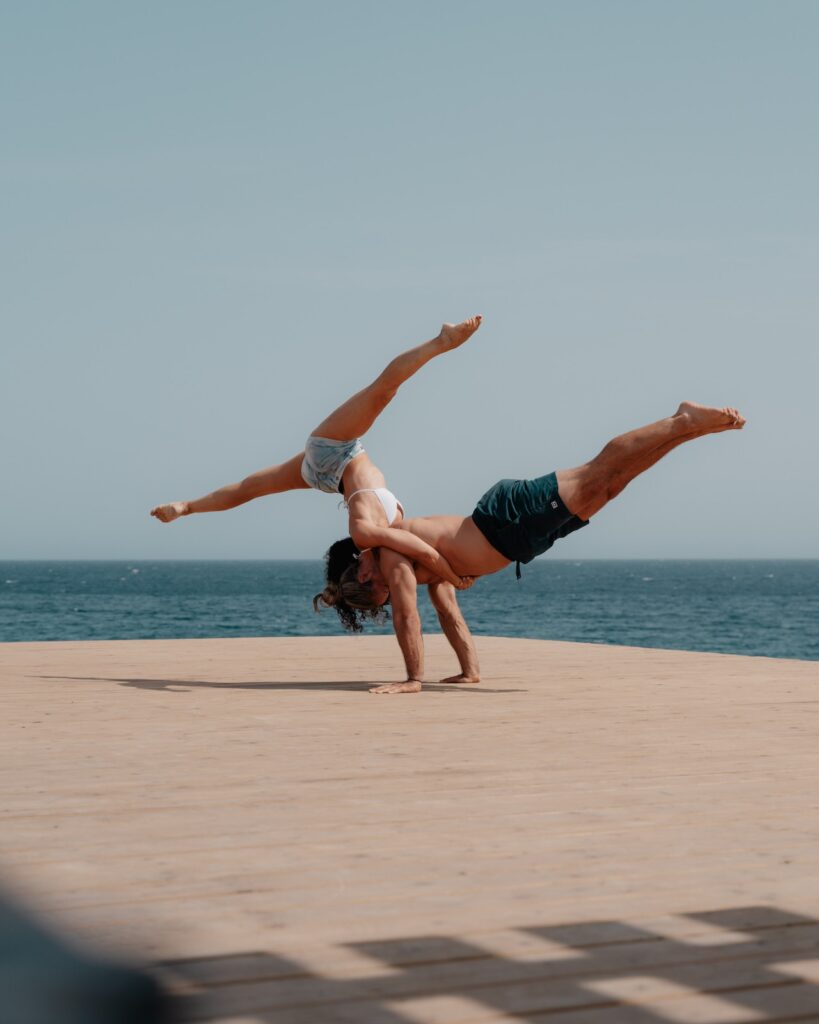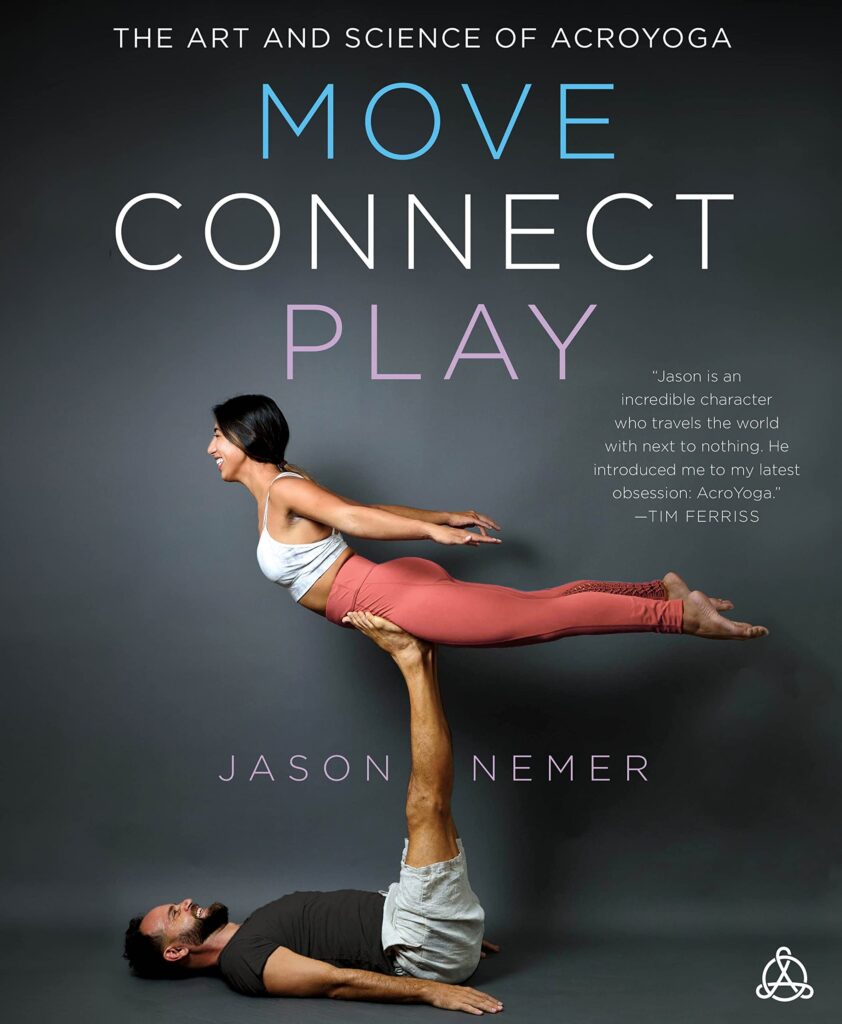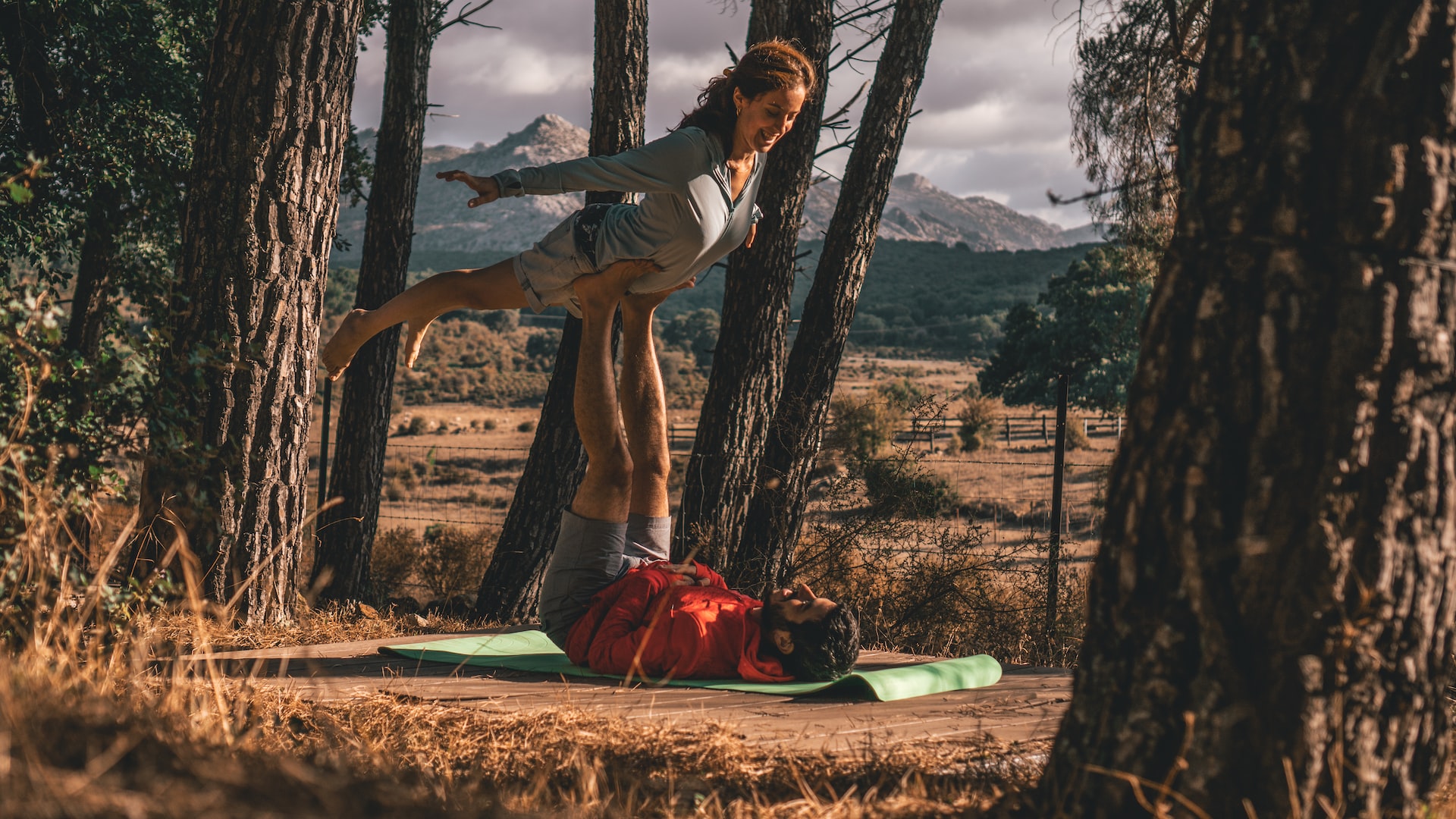Acroyoga requires strength, balance, and trust, and can be a fun and challenging hobby to exercise and connect with others!
This article contains affiliate links. If you make a purchase through a link on our site you are supporting our continued efforts to educate people like you in finding new and rewarding hobbies. Thank you!
What is acroyoga?
Acroyoga is an active, physical practice that combines elements of acrobatics, yoga, and mindfulness.
It is typically practiced in pairs or small groups, with one person serving as the base, one as the flyer, and one as the spotter.
The base supports the flyer in various poses, while the spotter provides additional support, guidance and safety.

How do you do acroyoga?
There are many different acroyoga poses, or “flows,” that can be performed, ranging from beginner to an advanced level.
Here is a basic outline of how to get started with acroyoga:
- Find a partner and a safe, flat surface to practice on, such as a mat, padded floor or yoga studio.
- Begin by warming up and stretching to prepare your bodies for the practice and reduce the chance of injury.
- Start with basic poses, such as the downward-facing dog or plank, to build strength and stability.
- Practice basic transitions, such as moving from a downward-facing dog to a plank or from a plank to a crow pose.
- Gradually add more advanced poses and flows as you and your partner become more comfortable and confident.
- Take breaks as needed and always listen to your body. It is important to practice acroyoga safely and to use proper techniques and spotting techniques to prevent injuries.
It is also a good idea to attend acroyoga classes or workshops led by experienced instructors, as they can provide guidance and support as you learn the basics of acroyoga practice.
Where can you do acroyoga?
Acroyoga can be practiced in a variety of settings, including:
- Yoga studios: Many yoga studios offer acroyoga classes as part of their regular schedule. These classes are typically taught by instructors who are trained in acroyoga and can provide guidance and support to help you learn the various poses and techniques.
- Parks: Some people prefer to practice acroyoga in a more natural setting, such as a park. If you have a partner or a small group of friends who are interested in practicing acroyoga together, you can find a suitable spot in a park and start practicing.
- Gyms: Some gyms have designated areas for acroyoga practice, or they may offer acroyoga classes as part of their fitness programming.
- Beach: If you live near the beach, you may be able to practice acroyoga on the sand. The sand provides a softer and more forgiving surface, which can be helpful for beginners or for people with joint issues.

What type of gear do you need to practice acroyoga?
You don’t necessarily need any specialized gear to practice acroyoga, but there are a few items that can help make your practice more comfortable and enjoyable. Some options might include:
- Yoga mat: A yoga mat can provide a comfortable and slip-resistant surface to practice on, especially if you are practicing on a hard or uneven surface.
- Wrist wraps or hand pads: If you are going to be supporting your body weight on your hands and wrists, it can be helpful to use wrist wraps or hand pads to protect these joints and reduce the risk of injury.
- Knee pads: If you will be doing poses that involve kneeling or placing pressure on your knees, it can be helpful to use yoga knee pads to protect your joints and reduce discomfort.
- Blocks: Acroyoga poses often involve stretching and reaching, and yoga blocks can be helpful for providing support and assistance in achieving proper alignment.
It’s important to note that acroyoga involves physical challenges and carries some inherent risks, and it’s important to use caution and common sense when practicing.
It’s also a good idea to start slowly and gradually build up your strength and skill as you become more comfortable with the practice.

Looking to learn a few basic acroyoga poses to get started? Check out these Three Foundational Acroyoga Poses as well as the various lessons on acroyoga offered by Masterclass.
What are the benefits of doing acroyoga?
Acroyoga is a physical practice that combines acrobatics, yoga, and Thai massage, and it offers a number of potential benefits for the body and mind. Some of the potential benefits of acroyoga include:
- Physical fitness: Acroyoga requires strength, flexibility, and coordination, and it can be an effective way to improve overall physical fitness.
- Stress relief: The combination of physical activity and relaxation techniques in acroyoga can help to reduce stress and promote feelings of calm and well-being.
- Improved flexibility: Acroyoga involves a variety of stretches and poses that can help to improve flexibility in the muscles and joints.
- Improved balance: Balancing poses and acrobatics in acroyoga can help to improve balance and coordination.
- Increased body awareness: Acroyoga involves mindful movement and attention to the body, and this can help to increase body awareness and improve overall body mechanics.
- Social connections: Acroyoga is typically practiced with a partner or in a group, and this can provide an opportunity for social connection and bonding.
It’s important to note that acroyoga requires a certain level of physical fitness and coordination, and it’s important to practice with a partner who is supportive and attentive to your needs.
It’s also a good idea to start slowly and gradually build up your strength and skill as you become more comfortable with the practice.
Check out Move, Connect, Play: The Art and Science of AcroYoga to learn a few basics and essentials of proper acroyoga practice.


